|
Uraniborg Observatory and Alchemy laboratory? Canopy of stars depicting astronomy and jars below depicting microscopes and/or medicine jars reflecting the use of the basement of Uraniborg as an Alchemical medicine laboratory. |
|
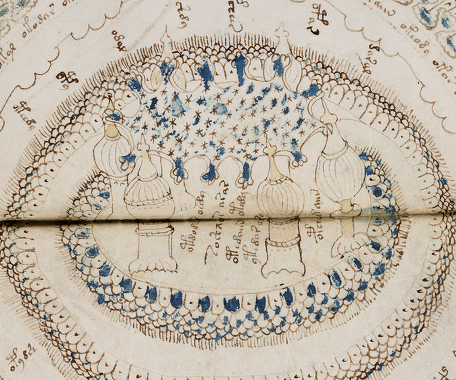 |
|
|
A QUESTION OF OPTICS.
The question whether optical devices are shown in the Voynich Manuscript or not has been an ongoing one. The recent dating of the manuscript would not allow the presence of such objects assuming it was written soon after production, and any such objects would call for a much later date for the actual writing of the manuscript. Richard Santa Coloma has done a great deal of research in this area already and his website contains details on this and his theory on the Voynich Manuscript and optics:
http://www.santa-coloma.net/voynich_drebbel/voynich.html#microscopes
Below, I lay out my own reasoning why I think it is likely optical devices are shown. It may seem strange to suggest that the work of Tycho Brahe is shown alongside telescopes when he was the last of the great “naked eye” pre-telescope astronomers, or that microscopes may be shown alongside dissected plants, but I suggest there are reasons why it may have been done.
I have suggested the main topic of the Voynich Manuscript is astronomy, but many of the folios are botanical and this juxtaposition at first sight seems bizarre, but not so when considering the philosophy of such times. An holistic approach to the subject matter of the universe, “as above, so below”, would encompass both heavenly astronomy and earthly biology and “optical devices” are consistent with the subject matter, even if sometimes they may be displayed in a theoretical retrospective manner. The Elizabethan age had stepped into but had not fully entered the separation of science, religion and superstition, science coexisted with all other spheres of life and some of the most forward thinking of the astronomers of this time, such as Tycho, still embraced many disciplines in the pursuit of a whole. During the 17th century the gap between science and other spheres of life grew and a more mechanised view of the universe emerged and the doctrines of previous generations began to be rejected in earnest and Astronomy, chemistry, biology, mathematics, physics and particularly optics were all revolutionised At this time tension also grew between the Chinese and Western astronomers and the two cultures had access to the data, ideas and expertise of the other, including the telescope. A juxtaposition of astronomy and botany expresses the earlier holistic approach and the inclusion of optical devices and new scientific observations made with such devices as has been suggested in places by me expresses the age of reason. These images all occurring side by side expresses the journey undertaken by science that began with the Renaissance and must speak of the clashes this journey entailed. The fact that the manuscript is encoded would suggest in this scenario that it would have been written somewhere along the journey when to express such ideas was still considered heretical and to hold, record or teach such ideas could result in imprisonment or execution.
The possible “optical devices” of various types occur in the manuscript are present only after what I have described as the work of Tycho Brahe. I suggested that telescopes might be shown on the rosette pages, but, Tycho did of course (as far as we know) not have access to telescopes and they may be a metaphorical inclusion for “examining the sky”, or even show“sight tubes”. In the same manner that those jars possibly considered to be “microscopes” could also be containers for medicine. However, the presence of telescope-like devices on the rosettes pages coinciding with a time of increased understanding of the universe that started with observations of SN 1572 is not without logic. It is reasonable to consider that a book exploring scientific progress in the understanding of the universe from this era would be showing such progress, even if the specific subject matter referred back to achievements/observations made before the devices in a retrospective manner, particularly to events of significance. There is also a possibility that Tycho knew of telescopes even if he did not have access to one and this is discussed later.
Microscopes, medicine jars or both?
|
Uraniborg Observatory and Alchemy laboratory? Canopy of stars depicting astronomy and jars below depicting microscopes and/or medicine jars reflecting the use of the basement of Uraniborg as an Alchemical medicine laboratory. |
|
 |
|
|
The central rosette is made up of towers holding up the stars, these towers look very similar to some of the optical devices/containers on the plant pages and suggest a link with the later jars and the work of Tycho. Tycho was also a Paracelsian alchemist as well as astronomer, and one side of the basement of Uraniborg was used for his alchemical experiments and distillation of herbs from his garden for the preparation of medical remedies. The jars in this rosette may be medicine jars and yet they hold up the canopy of stars that indicates the observatory above, suggesting a link between the jars, astronomy and the botanical folios. The connection may be the philosophical one “as above, so below”, “so below” in this instance indicating the earthly discipline of biology of which medicine is a part and progress from this time in biology was aided by the microscope in the way astronomy was by the telescope. In other words medicine vials or microscope, or a mix of both, would not be out of place - maybe the difference indicated by the difference in design between the fatter, plainer jars and the slimmer, elaborate jars?
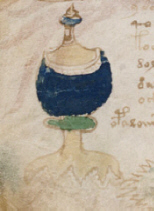 |
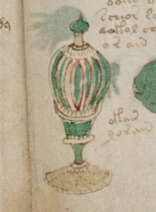 |
||
|
|
Apart from the rosettes folio, the jar like objects suggested to be “optical devices” only occur towards the end of the manuscript where dissected plants are shown and not in the beginning where only whole plants are shown, this suggests a connection between the “optical devices” and the smallness of the plant sections. The earliest remaining example of a microscope has been attributed to Janssen, around 1595, which is just two years before Tycho left the island of Ven. A thorough comparison of these various jars with microscopes can be found on Richard Santa Coloma’s website.
|
|
|
|
|
| f99r, cropped. Voynich Manuscript. Credit: Beinecke Rare Book and Manuscript Library, Yale University. | f102v, cropped. Voynich Manuscript. Credit: Beinecke Rare Book and Manuscript Library, Yale University. | f88r, cropped. Voynich Manuscript. Credit: Beinecke Rare Book and Manuscript Library, Yale University. | f88r, cropped. Voynich Manuscript. Credit: Beinecke Rare Book and Manuscript Library, Yale University. |
The flatter, plainer jars look more like early microscopes and some of the jars in the central rosette look to be this type but with lids. This type of jar occurs distinctly in quire 19 and shows elaboration on the last two folios of the quire. The slimmer, elaborate jars occur specifically in quire 15 and are all lidded with the exception of the first jar (shown second jar from the left above), which without its lid looks once again more like a microscope than a medicine jar. Both quires show the jars alongside parts of plants with roots, whole plants are shown on folios in between but never together with the jars.
Telescopes?
| Telescopes? | ||||||
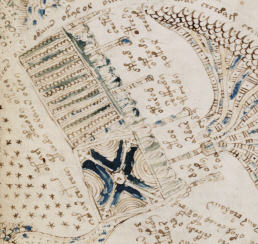 |
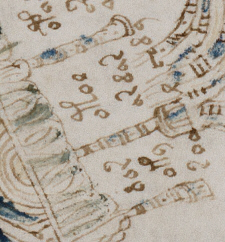 |
|
||||
|
|
|
||||
The bottom right rosette, and in a slightly different design the central and top left rosettes, show tubes. These tubes may be sight tubes that had been used since ancient times but the ones in the bottom right rosette look remarkably like the earliest telescopes. If the manuscript was written long after Tycho’s death then such objects may have been added metaphorically but it is also possible that he knew of such devices from England, long before1608.
Hans Lippershey, the Dutch lens maker is credited as the inventor of the telescope in 1608, or to be exact was the first to apply for a patent for his working model of a glasses device which made things far away appear near which he claimed was a new invention - not quite the same thing. If we look to England, John Dee in 1570 makes reference to “Perspective glasses” in the preface of a book by Billingsley and in 1572 Thomas Digges refers to “Perspective glasses” in his edition of “Pantometria” (a book by his father Leonard Digges which describes the effects of combing lenses and different magnifications). Later Lord Burghley is recorded to have commissioned William Bourne to look into the claims made by Dee and Digges and in his report he concludes that given concave Looking Glasses with different types of lenses, in number and of large enough size, then one could see small things at a great distance – without doubt. So it was concluded that such a device probably did exist and when Thomas Digges refered to the devices his father made he referred to them as actual devices rather than theoretical, and he states in the preface of “Pantometria”:
“my father by his continual painful [painstaking] practices, assisted with demonstrations Mathematical, was able, and sundry times hath by proportional Glasses duly situate in convenient angles, not only discovered things far off, read letters, numbered pieces of money with the very coin and superscription thereof, cast by some of his friends of purpose upon downs in open fields, but also seven miles off declared what hath been done at that instant in private places.”
Thomas Digges, Pantometria,1571.
Source: Wikipedia.
Leonard Digges was a friend of Dee and when he died Digges entrusted the upbringing of his son, Thomas, who was 13 at the time, to Dee. In 1572 Digges and Dee made observations together of SN 1572 and although it is not recorded that they used working telescopes to aid them this is a possibility. In 1573 Thomas Digges published “Alae seu Scalae Mathematicae”, in which he looks in detail at SN 1572 with such precision that his measurements were only slightly less accurate than the observations of Tycho. Tycho incorporates some of the work of Digges into his own book “Astronomiae Instauratae Progymnasmata”, his second on the new star (“De Nova Stella”, 1573, was his first) which was completed and published in 1602 by Johann Kepler. Dee also published a book on his observations of the new star and gave trigonometric methods which were applied to find the distance to the new star. The lack of parallax noted by Tycho, Digges and Dee paved the way for a revolution in astronomy, they had proven that this star was further away than the Moon and had thus appeared in a place that was deemed to be immutable. Thus, observations of SN 1572 were made at a time and by persons who knew of and probably had access to some type of telescope or “Perspective glasses” as they were known, and these persons were known of by Tycho and vice versa. Dee was a friend, Kepler a collegue and Tycho and Digges corresponded. Also, Tycho, Dee and Kepler all worked at some time for Rudolph II and in some way were all revolutionary in dispelling the immutability of the heavens and rejecting the traditional geocentric model of the Universe, although Tycho attempted to unify the heliocentric and geocentric concepts by keeping a geocentric model but having the planets orbit the Sun which orbited the earth. Therefore, SN 1572 represents much more than just another star, it is the star that overturned the universe as did the telescope and placing the two together speaks of revolution and new order, which was understood by some of the greatest names of the day, and the risk associated with this new doctrine was understood also.
The earliest known depiction of a “Spyglass” or simple Galilean telescope is in “Extensive Landscape with View of the Castle of Mariemont” by Breughel dated 1608-11. Breughel also included spyglasses and Keplarian type telescopes in other of his paintings, details of these paintings depicting telescopes can be found in a paper on the “rxiv” link of the website below:
http://www.galileosstudio.org/
| Complex telescope? | 1617. Keplerian telescope? | |
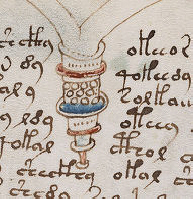 |
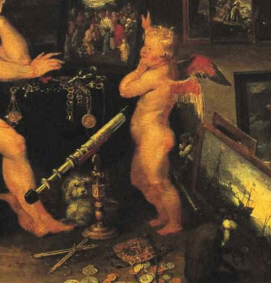 |
|
|
The sight, 1617, by Jan Brueghel the Elder (1568 - 1625), cropped. PD image. Source Wikimedia Commons. |
If the tubes on the rosettes folio are indeed telescopes, then this later example on a folio may well be a later complex telescope. The earliest known depiction of a complex telescope such as this is in “the sense of sight” also by Breughel (and Rubens), dated 1617, which also has distinct circular bands at the end of each section and more sections. It is shown together with an early type Galilean telescope and pair of lenses to the right:
http://upload.wikimedia.org/wikipedia/commons/2/21/Bruegel_d._%C3%84.%2C_Jan_-_The_Sense_of_Sight_-_1618.jpg
Where does all this lead to and why are the paintings significant? If the Voynich manuscript does indeed have depictions of simple and complex telescopes then the paintings of Breughel suggest it is likely to have been written after 1618, alternatively, the manuscript shows the earliest depictions of telescopes. A post 1618 date however is now in conflict with the latest results from the radiocarbon dating of the manuscript, and a manuscript from circa 1400 should not contain neither such objects, nor microscopes. I have suggested that some of the subject matter in the “biological” quire refers to constellations which did not exist before the late 17th century, by this times optics were well advanced and their presence in a document form this date is credible and missing folios referring to even later events cannot be ruled out, pushing the possible time of authorship even further into the age of optics and further away from the radiocarbon date.
Further information on early telescopes and microscopes
The telescope quickly advanced and became more complex
during the 17th century. There is an example of an 8 sectioned telescope by
Giuseppe Campani, c.1664:
http://brunelleschi.imss.fi.it/esplora/cannocchiale/dswmedia/storia/immagini/04/06.jpg
Other examples of early multi-section telescopes
http://brunelleschi.imss.fi.it/esplora/cannocchiale/dswmedia/storia/stampa.html
http://www.imss.fi.it/news/cielimedicei/03/estrumento8.html
|
Medicine jars or the evolution of microscopes from simple to complex depicted? Shown without storage lids? |
Medicine jars or later microscopes depicted? Shown with storage lids? Left shown in cut away profile? |
|||||
|
|
|
|
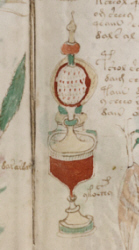 |
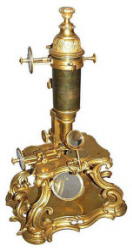 |
||
| f99r, cropped. Voynich Manuscript. Credit: Beinecke Rare Book and Manuscript Library, Yale University. | f101v, cropped. Voynich Manuscript. Credit: Beinecke Rare Book and Manuscript Library, Yale University. | f102r, cropped. Voynich Manuscript. Credit: Beinecke Rare Book and Manuscript Library, Yale University. | f88v, cropped. Voynich Manuscript. Credit: Beinecke Rare Book and Manuscript Library, Yale University. | Later (1751) but beautiful example of microscope with lid. Licence GNU Free Documentation/Creative Commons Attribution ShareAlike 3.0. Credit:© Roby 11 janvier 2005. Wikimedia Commons. | ||
Some links to early, simple microscopes:
http://microscope.fsu.edu/primer/museum/janssen.html
http://brunelleschi.imss.fi.it/museum/esim.asp?c=408001
http://brunelleschi.imss.fi.it/museum/esim.asp?c=408003
http://microscope.fsu.edu/primer/museum/galileo.html
Some links to later, more complex microscopes:
http://microscope.fsu.edu/primer/museum/yarwelllate1600s.html
Copyright © 2010 P. Han